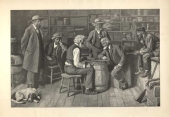The Checker Maven
The World's Most Widely Read Checkers and Draughts Publication
Bob Newell, Editor-in-Chief
Published every Saturday morning in Honolulu, Hawai`i
Noticing missing images? An explanation is here.
A Dishpan Move

We've heard various names given to a losing move in a checker match; these epithets range from the rather mild "unfortunate" to the somewhat stronger "poor" and on up from there to other things that we certainly won't print here.
In the following game, played in the early 1930s between very strong players, such a move was made. When the game was published, the losing choice was called a "dishpan" move, a term which we hadn't heard before. It's an amusing and appropriate choice of words. Let's have a look at the game in question.
9-13 24-20 5-9 22-18 10-15---A 25-22 6-10 27-24---B 10-14 22-17 13x22 26x10 7x14---C 30-26 15x22 26x10 2-7 10-6 1x10 29-25 10-15 23-19 9-13 19x10 7x14 24-19 3-7---D
A---10-14 is often played instead; there is little difference.
B---28-24 is just as good.
C---15-22 same.
D---It was textbook play up to this point. The original editor called this a "hasty dishpan move" noting that the player "must have eaten too much for dinner."
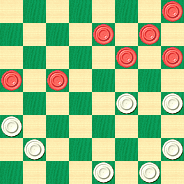
WHITE
White to Play and Win
W:W32,31,28,25,21,20,19:B14,13,12,11,8,7,4.
Will this one wash, or will this position "sink" you? Find the win for White, and while you're at it, correct Black's losing "dishpan" move. When you're done, clicking on Read More will bring you cleanly to the solution.![]()
D. Robertson, Clockmaker and Checkerist?

We looked for references to "D. Robertson," to whom today's Checker School studies are credited. We didn't directly find anything about this old-time checkerist, but we did find the beautiful old-time clock replica above, appropriately titled the "D. Robertson" model. Now, checkerist Robertson hailed from Scotland in the late 1800s. The clock above is a copy of a Scottish clock that, at least by appearance, may have dated from around the same time. Could D. Robertson, checkerist, have also been D. Robertson, clockmaker? We made some inquiries, but didn't come up with any clear answers. Still, the possibility is intriguing.
Once sold by a company appropriately called Timeworks, the above clock replica is, sadly, no longer in their catalog. In fact, the era of analog clocks itself seems to be passing; we're surprised at the number of younger people today who can't read anything but a digital clock. We could continue the theme by further waxing nostalgic about the heyday of checkers, but instead we'll get back on track and present Mr. Roberton's positions.
| D. ROBERTSON | D. ROBERTSON |
| WHITE | WHITE |
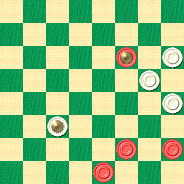 | 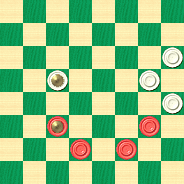 |
| BLACK | BLACK |
| Black to Play and Win | Black to Play and Win |
| B:W21,17,13,K11:BK22,6,5,2. | B:W21,K19,17,13:BK11,9,7,6. |
At first glance the positions look balanced, but White's group of three men on the left lacks mobility, and that's often a fatal flaw in checkers. Still, finding the win will require clockwork precision.
Now, this isn't a "beat the clock" speed position, so take all the time you wish before clocking your solution. Then move your hands (remember, it's an analog clock) to Read More to see the solutions, four sample games, and detailed notes.![]()
McKelvie's Masterpiece

Once again, we hope we've fooled you. With an article title containing the word "Masterpiece" you probably expected to see the Mona Lisa or some other famous work of art. However, we wanted to showcase something that not only featured the word "masterpiece" but also the name "McKelvie." Well, we didn't come up with an artist named D. McKelvie, but we did find J. McKelvie, a talented illustrator for on-line and print comics. "Li'l Depressed Boy," if you're not familiar with the series (and we certainly weren't) is a comic that started on the internet and now appears in print form. We can't say we're going to rush right out and buy it, but we can say that J. McKelvie is certainly a talented artist who produces masterpieces in their own genre.
Does J. McKelvie play checkers? We don't know, but D. McKelvie certainly did back in his day, and this month's excerpt from Willie Ryan's Tricks Traps & Shots of the Checkerboard features play attributed to the Mr. D. McKelvie, as Willie explains in somewhat taciturn fashion.
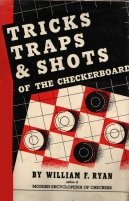
| 9-13 | 21-14 | 3- 7 |
| 21-17 | 12-16 | 20-11 |
| 5- 9 | 24-20 | 7-16 |
| 25-21 | 16-19 | 31-27 |
| 11-15 | 25-21---1 | 1- 5 |
| 29-25 | 4- 8 | 14-10 |
| 9-14 | 32-27 | 6- 9 |
| 23-18 | 8-12 | 10- 6 |
| 14-23 | 27-24 | 9-14 |
| 27-11 | 12-16 | 21-17 |
| 8-15 | 20-11 | 14-21 |
| 17-14 | 7-16 | 6- 1 |
| 10-17 | 24-20 | 5- 9---A |
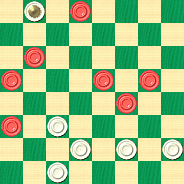
WHITE
White to Play and Win
A---The loser. 16-20, 27-23, 20-24, 23-16, 24-27, 16-11, 27-31, 11-8, etc., is the correct play to draw."
1---32-27 might have been better but this line seems to equalize---Ed.
Can you create a masterpiece, or will you become a "Li'l Depressed Boy" yourself? Avoid depression by depressing your mouse on Read More to see the spectacular solution.![]()
Ballroom Dancing

Marvin J. Mavin had seemingly mended his errant ways, and had returned to the captaincy of the Detroit Doublejumpers in the National Checker League. (In a previous column we related how Marvin had been sent down to a single-A farm club after showing disrespect to his manager.)

Marvin J. Mavin
Today, the Doublejumpers were in Miami for an exhibition match with one of Florida's top amateur teams, the Dancing Draughtsmen. Sponsored by the National Ballroom Dance Federation (NBDF), the Dancing Draughtsmen were captained by none other than NBDF President Vincent "Vinnie" Boggler. Vinnie, in addition to being a ballroom dancing star, was a strong amateur checker player who could have turned pro had ballroom dancing not been his first love.

Vincent "Vinnie" Boggler
A large crowd was in attendance to cheer for their local favorites and their anticipation grew as match time approached.
Marvin, in his position at first board, was making what he thought were clever remarks to himself prior to Vinnie's arrival. "Ballroom dancing," he muttered. "That's for old fogeys who watch too many movies with that guy Freddie whatchacallit. Give me a rave any day!"
"Did you say 'rave'?" he heard a voice ask. Marvin looked up and his face immediately turned red. Vinnie had arrived and evidently had heard Marvin's last comment.
"Raves are for people with no dancing talent. Not everyone has what it takes to excel at ballroom dance. And," Vinnie continued, "not everyone has what it takes to excel at checkers." With this, he gave Marvin a pointed look and offered to shake hands. Marvin did so in a half-hearted fashion. Embarrassed on the one hand for being overheard, he was angry on the other over Vinnie's sharp put-down.
Vinnie took his seat just as the whistle blew to signal the start of the match, and didn't hear Marvin mutter, "From the looks of you, you ain't never been to a rave, ballroom boy, and you don't know the first thing about them."
The game started out as follows.
| BLACK | WHITE | |
| Vinnie | Marvin | |
| 1. | 10-14 | 24-19 |
| 2. | 11-16 | 28-24 |
| 3. | 9-13---A |
Marvin was grinning and couldn't keep back a comment. "Nerves, Vinnie? Three moves and you already blew it," he said. "Face it. I'm a checker pro and you're some kind of fancy-pants dancer. You don't have a prayer." And so saying, Marvin quickly made his move---- a little too quickly, in fact.
| 3. | ... | 22-17---B |
Marvin sat back in his chair with a smug expression, then took a second look at the board. His expression quickly changed, being replaced with one of concern, then of dismay. Vinnie looked at him and smiled. "Trip over your own feet, did you? Nerves, Marvin?' he asked.
| 4. | 13x22 | 25x9 |
| 5. | 5x14 | 26-22 |
Vinnie concentrated intently. He and Marvin both knew that Black now had a draw in sight. The margin was slim and careful play would be necessary, but Vinnie was determined to put Marvin in his place. For his own part, Marvin knew that he had blown away the win. He could only hope that Vinnie stumbled in his attempt to find the right steps that lead to the draw.

BLACK (Vinnie)
Black to Play and Draw
B:W32,31,30,29,27,24,23,22,21,19:B16,14,12,8,7,6,4,3,2,1.
A---A weak move which very likely loses. 7-10 or 6-10 would have been best.
B---22-18 preserves the probable win.
Can you match steps with Vinnie and find the draw, or will the rhythm elude you? We'll warn you up front that the path to a draw is a long one. Take a whirl with it and then dance your mouse over to Read More to see the solution and the conclusion to our story.![]()
Brush Stroke

Once before, we thought we had run out of plays on the word "stroke" but the Checker Maven staff managed to come through. This week, they've done it again, although warning that it would probably be the last acceptable instance of "stroke" wordplay.
We're not at all sure that we would cover our office walls with the color selected by the woman in the photo above, but you get the idea, and for all we know, she might be an expert checker player in addition to modeling brush strokes.
Today's stroke problem is indeed no brush-over; it's complex and requires the best in visualization skills.
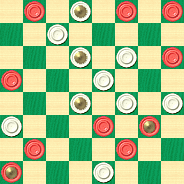
WHITE
White to Play and Win
W:WK2,6,K10,11,15,K18,19,20,21,31:B1,3,4,12,13,23,K24,25,27,K29.
Don't paint yourself into a corner, and after a good brush with this problem, click on Read More to see the solution.![]()
Petterson's Drawbridge

The beautiful old drawbridge shown above is at the entrance to the walled Dutch town of Heusden, which lies on the Maas River. We think it's a fitting illustration for today's Checker School lesson, which is about the classic "Petterson's Drawbridge" position.
We always ask when we present material on a well-known position: How well do you really know it? We're certain that our more advanced readers know it pretty well, but a thorough review never hurts; and for everyone else, this is a great opportunity to master this very difficult end-game formation. Here are two examples for you to try out. You might wish to attempt the second one first.
| R.D. PETTERSON | J. BRADLEY |
| BLACK | BLACK |
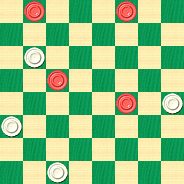 |  |
| WHITE | WHITE |
| White to Play and Draw | White to Play and Draw |
| W:W9,20,21,30:B1,3,14,19. | W:WK2,10,20,21:B1,3,K18,K19. |
When you've crossed this bridge, or more correctly, these bridges, cross your mouse over to Read More to see the solutions, four sample games, and detailed study notes. If you go over all of this material carefully, you'll be a drawbridge expert (of the checker variety, at least) and your cross-board results will definitely improve.![]()
Reed's Rocket

Given the title of today's column, we'll guess that you were expecting to see a picture of a powerful rocket blasting off from its launching pad. Instead, what you see above is an ingenious device called the Reed Rocket Nutcracker. We suppose that when you have "a tough nut to crack" this device will provide all the cracking power you'll ever need. But for cracking less resistant nuts, perhaps an old-fashioned low-tech nutcracker might do the job without the set-up time the "rocket" appears to require.
Old-time checkerist C. F. Barker was certainly a tough nut to crack, but in Willie Ryan's Tricks Traps & Shots of the Checkerboard, Willie describes just how James Reed did exactly that.

"Here is how James P. Reed, of Pittsburgh, Pennsylvania, put the skids under Boston's renowned Charles Francis Barker, in an American Championship match in 1889:
| 10-14 | 21-14 | 6-10 |
| 22-17 | 9-25 | 27-24 |
| 7-10 | 29-22 | 1- 6 |
| 17-13 | 10-14 | 19-15 |
| 3- 7 | 22-18 | 10-19 |
| 25-22 | 14-17 | 24-15---1 |
| 14-17 | 24-19 | 12-16---A. |
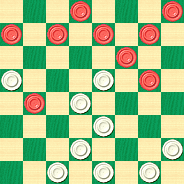
WHITE
White to Play and Win
W:W32,31,30,28,26,23,18,15,13:B17,16,11,8,7,6,5,4,2.
A---Fatal. 6-9 or 11-16 will draw."
1---Play has been textbook perfect to this point---Ed.
You know what we're going to say now: Can you crack this position, or will you crack up trying? Take a crack at it, and then crack that mouse on Read More to see the powerful solution.![]()
21st Century Checkers: the 9-14 "Double Corner" Ballots

Today we are pleased to present the second volume of Grandmaster Richard Paskís new work on the 3-move openings: 21st Century Checkers 9-14s, or the Double Corner ballots.
As he did with volume 1, Mr. Pask is making this work available in electronic format, free of charge.
The new book can be downloaded here, and will soon appear on our Richard Pask page as linked in the right-hand column; a large selection of Mr. Paskís other works can also be found there.
Hereís a position taken from the book. The run-up to the diagram is as follows.
9-14 23-19 5-9 27-23 11-15 22-18 15-22 25-18 7-1; 26-22 11-15 18-11 8-15 24-20 15-24 28-1; 4-8 22-18 8-11 30-26 2-7
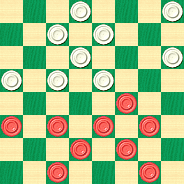
BLACK
Black to Play and Win
B:W31,29,27,26,23,21,20,19,18:B14,12,11,10,9,7,6,3,1.
What would have been the correct move? Can you show the win after 32-27? Can you work all of this out on your own?
See how far you can get, and then click on Read More to see the solutions. And, of course, donít forget to download the book! Our sincere thanks go to Mr. Pask for allowing us the privilege of presenting his new book.![]()
Labor Day 2011

Labor Day is another holiday that we particularly like because, as we note every year, it celebrates the greatness of the common guy and gal, those hard-working not-so-ordinary "ordinary" folk who have made America what it is today.
We're sorry to say that our politicians have in recent times let the common man down, seemingly oblivious to the economic plight faced by so many. We know that the problems of the American economy are tough ones and not easy to solve, but if there's a will there's a way. It's just that we haven't seen much in the way of will from our leaders in Washington.
So The Checker Maven would like to tell these leaders: Millions and millions of Americans want and need something better, and they're willing to work long and hard to make it happen. You need to help them out. The American workforce is nothing less than awesome. Don't let us down any longer!
We always celebrate this holiday with an offering from one of the greatest American problemists, Tom Wiswell, and Mr. Wiswell is certainly someone who never lets us down. Here's one that we know you will enjoy. It isn't easy, but it's elegant and a bit surprising.
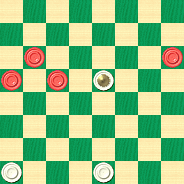
WHITE
White to Play and Draw
W:W31,29,K15:B14,13,12,9.
White is a man down and will have to truly labor to obtain a draw. A lot of checker insight is needed to visualize the conclusion. We suggest that you put in your hours and work on this one; if you're able to solve it you'll feel amply rewarded. Then be sure to enjoy Labor Day along with us; you've certainly earned it.![]()
A Great Checker Resource: Google Books

In recent years, checker books have been hard to come by and often expensive. Publication of new checker books has slowed to a trickle; and while most if not all of the new books are very fine indeed, they are often sold in limited quantities through private sources. It all makes it difficult for the new checkerist looking for study material, the collector looking to broaden his collection, or the experienced player looking to expand his horizons even further.
The Checker Maven has reproduced a number of checker works, both old and new, in newly typeset editions; these have met with a generally enthusiastic reception. But as a small publisher there's a limit to how much we can produce, and it's never as much as we or the checker-playing public would wish.
Enter Google Books (books.google.com), which has as its goal the colossal task of digitizing the world's books, both new and old. An incredible and growing selection is available on-line, and checker books have not been neglected.
Go to the site and search for "checkers" or "draughts" and you'll see what we mean. Dozens of books are listed. While a good part of the collection just shows the book cover or a brief extract, there are numerous books listed as free Google ebooks, and these are yours for the taking. The free books tend to be older classics, but what better way to build or expand a collection of quality checker literature?
There are a few limitations. The books are PDF images and are not electronically searchable; some of the scans are imperfect, and of course they look like what they are: images of the pages of old books. But trust us, you'll want to download many of these. They can easily be printed and used in hard-copy, or simplest of all, just read on the computer.
In today's column we'd like to feature a game from one of the real finds on the site, the match book from the 1887-8 contest between Charles Barker of America and James Smith of Scotland. If you don't have this book in your collection, by all means get it for free from Google Books.
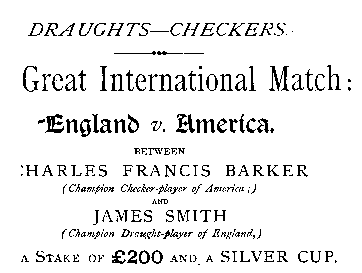
The match was won in a convincing fashion by the American champion Barker. Here is the run-up to the critical position in game four, in which Barker drew first blood.
| 1. | 12-16 | 24-20 |
| 2. | 8-12 | 28-24 |
| 3. | 3-8 | 21-17 |
| 4. | 16-19 | 24x15 |
| 5. | 10x19 | 23x16 |
| 6. | 12x19 | 17-14 |
| 7. | 9x18 | 22x15 |
| 8. | 11x18 | 26-22 |
| 9. | 7-11 | 22x15 |
| 10. | 11x18 | 20-16 |
| 11. | 8-12 | 16-11 |
| 12. | 19-24 | 27x20 |
| 13. | 6-10 | 30-26---A |
Forms diagram.
A---Definitely loses.
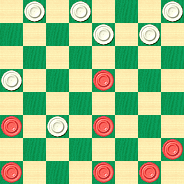
BLACK
Black to Play and Win
B:W32,31,29,26,25,20,11:B18,12,10,5,4,2,1.
Can you correct the losing move? Can you find the winning line of play and book the win? Or will the page turn on you? Find the answers and then click on Read More to scan the solution.![]()
The Checker Maven is produced at editorial offices in Honolulu, Hawai`i, as a completely non-commercial public service from which no profit is obtained or sought. Original material is Copyright © 2004-2025 Avi Gobbler Publishing. Other material is public domain, as attributed, or licensed under Creative Commons. Information presented on this site is offered as-is, at no cost, and bears no express or implied warranty as to accuracy or usability. You agree that you use such information entirely at your own risk. No liabilities of any kind under any legal theory whatsoever are accepted. The Checker Maven is dedicated to the memory of Mr. Bob Newell, Sr.

